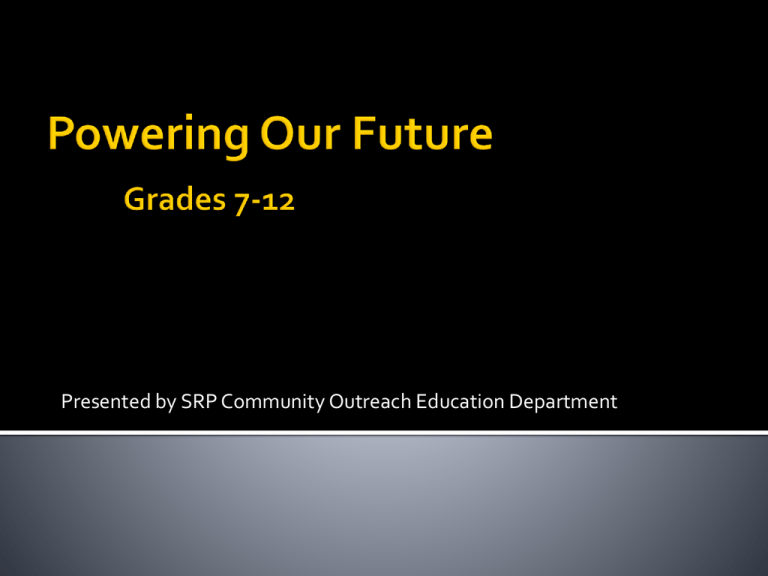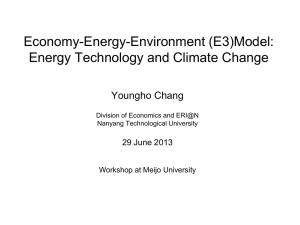Powering Our Future Grades 4-6 and 6
advertisement

Presented by SRP Community Outreach Education Department Introductions Energy Bumper Stickers What should we teach about energy? Overview of Program Natural Resources Do it All: Card Game (6-8, Unit 1, Lesson 1) Electrical Energy Generation Jigsaw Moving Electrons Solar Inquiry Poweringourfuture.com Reflection/Evaluation WINTRBIN Building an Understanding about Energy Identify basic concepts of energy Write ONE concept on each cup Stack them to symbolize the knowledge that builds the foundation for energy literacy Put the Energy Literacy cup on the top Renewable Energy Curriculum Materials 3 modules 3rd-6th 6th-8th High School – solar focus Created with the help of over 70 local educators Correlated to State Standards Create a Pie Chart Use different colors for different sources. For example, solar might be green and hydro power might be blue. Use the template as a guide. Think of all the ways electricity is generated. Think about what percentage or fraction each source is of all the electricity Arizona generates. There are 12 sections. Think in terms of fractions or percentages. Try to think of all the sources Arizona uses. Assign a value to each. Natural Resources Linked to Generate Energy in Arizona 2% 25% 44% 5% 22.5% 1.5% Natural Resources Used to Generate Energy in Arizona 2% 25% 44% 5% 22.5% 1.5% Source: U.S. Energy Information Administration, 2013 Coal Solar Natural Gas Hydro Nuclear Other Renewables Natural Resources Used to Generate Energy in the U. S. 2% 31% 39% Coal Solar Natural Gas Hydro 7% Nuclear 20% 1% Source: U.S. Energy Information Administration, 2012 Other Renewables Natural Resources Used to Generate Energy in Arizona U.S. Coal 2% Solar 25% 44% 5% 22.5% Coal Natural Gas Nuclear Other Renewables Solar 2% Hydro 1.5% Arizona Natural Resources Used to Generate Energy in the U. S. 31% 39% Natural Gas Hydro 7% 20% Nuclear 1% Other Renewables 9% 2% Nuclear 45% Other 36% 8% Coal Sustainable Resources Natural Gas Total Capcity 7,501 MW 4% Solar 39% 38% Energy Efficiency Biomass Wind 11% Geothermal 4% 2% 2% Landfill Gas Hydropower Total 9% of Retail Sales You have different sources of electricity generation on your tables. Each set shows the electrical generation process Sort the cards at your table in the correct order. You may not need to use all the cards. Once you have it, line up the cards along the wall in order. Learn about ten energy sources Use the Frayer Model NEED.org infobooks Definition (in your own words) Facts/Characteristics Important To Know Challenges With your group, read your expert passage to learn about your form of energy Write what you have learned on your poster • • • • Definition Facts Important to Know Challenges Definition (in your own words) Facts/Characteristics Important To Know Challenges What similarities do you see? Is there anything different in the process? Which ones would you consider “efficient”? Which ones would you consider “green”? Which is the cheapest? Which is the most expensive? Connect the hand-crank generator to the test bed. Set the switch to “Incan” for incandescent bulbs. Turn the generator and see if you can light all the lights. Now set the switch to LED and turn the generator again. What happened? Discuss at your table. Passive Solar Daylighting Active Solar Heating Concentrating Solar Power Power Tower Photovoltaics PV Cell PV Array Components oPV Cells oModules oArrays PV System Components Solar Fountain Activity A Solar Hydro Experiment Solar Fountain Activity 1. 2. 3. 4. 5. 6. 7. 8. 9. Assemble your solar fountain Fill your pan with water Go outside and point your PV cell in the directions on the chart Hold your PV cell at the different degrees using your protractor to measure Rate the flow from the fountain from 1-5 Write the flow number on the chart Experiment to find the best position for your PV cell Find a plant to dump your water on Come back inside and write 3 statements based on what you’ve seen North Flat/ Horizontal 45 degrees 65 degrees 90 degrees (perpendicular) Optimum/ Most productive East South West Divide students into three teams • Hydropower • Solar power • Wind power Construct eJournals Computers and headsets for student teams http://www. poweringour future.com / www.poweringourfuture.com Lesson plans tied to standards by grade and ejourneys (also on your disc) www.srpnet.com/education Materials, lessons, powerpoints, resources www.NEED.org Energy Books, kits, and ideas www.azsta.org Arizona Science Teachers Assn. For Science and energy-related products: www.arborsci.com www.deltaeducation.com www.hometrainingtools.com www.amazon.com $350 available To teachers who have attended a POF training For supplementary materials and supplies to teach the hands-on components of the curriculum. Examples: solar cells, circuit boards, generators You will be sent an email from SRP Accounts Payable to set up an account for you in a few days (after I approve) Follow the directions on the link You will receive a W-9 form. You need to print it, sign it, and scan it back in and return it. The information only goes to Accounts Payable and is destroyed once payment is made. Please take a moment to fill out a reflection and evaluation form. More resources available at www.srpnet.com/ education and http://www. Poweringourfuture.com/









